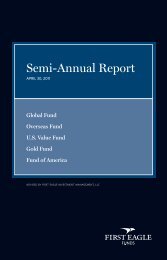Inside this Issue - First Eagle Funds
Inside this Issue - First Eagle Funds
Inside this Issue - First Eagle Funds
You also want an ePaper? Increase the reach of your titles
YUMPU automatically turns print PDFs into web optimized ePapers that Google loves.
a private-market intrinsic value of around<br />
$40 per share.<br />
Are the biggest risks here cyclical?<br />
AD: The health of the business is closely<br />
tied to employment, so continued rising<br />
unemployment would likely not be a positive<br />
for the share price. That could be<br />
partly offset – or exacerbated – by the<br />
direction of fuel prices, which are a big<br />
cost component.<br />
A more structural risk is that attempts<br />
to unionize the Cintas workforce gain<br />
steam with the advent of new labor laws<br />
and regulations proposed by the current<br />
administration. The company today has<br />
34,000 employees, of which around 400<br />
are unionized, so any significant shift<br />
toward a more unionized employee base<br />
could have a highly negative impact on<br />
margins. They’ve been successful in<br />
avoiding unionization so far, but it’s<br />
clearly an issue we have to keep a close<br />
eye on.<br />
You’ve spoken about the general merits<br />
today of exposure to gold. Describe the<br />
specific merits of your holding in South<br />
Africa’s Gold Fields [GFI].<br />
MM: In addition to owning gold in a<br />
vault, we are also more than willing to<br />
own it in the dirt if we get the right<br />
price. In buying shares in a company like<br />
Gold Fields, we believe we’re effectively<br />
buying the metal at a discount to its<br />
market price.<br />
The company is one of the largest global<br />
gold miners, producing around four<br />
million ounces per year from mines in<br />
South Africa, Peru, Ghana and Australia.<br />
Our valuation of gold producers basically<br />
consists of going mine by mine and looking<br />
at the reserves in the ground and the<br />
costs to extract them, taking into account<br />
things like labor cost escalations and tax<br />
leakage. In Gold Fields’ case, it has close<br />
to 85 million ounces of proven reserves<br />
overall, and its cash costs of extraction<br />
average around $500 per ounce.<br />
One thing we may do a bit differently<br />
in our analysis is that we don’t significantly<br />
mark down the value of long-<br />
June 30, 2009<br />
lived reserves, which is effectively what<br />
people do when they discount the estimated<br />
cash flows from future reserves<br />
back to today. Over long periods of<br />
time, the price of gold has gone up in<br />
nominal terms at CPI plus a little, so<br />
we’d argue that the real value of reserves<br />
ten or twenty years out is not that different<br />
from the value today.<br />
As a buyer of Gold Fields’ stock [at a<br />
recent price of $12.40], you’re paying<br />
$500 per ounce in extraction costs, plus a<br />
premium that is the market cap of the<br />
company. As we calculate it, then, you’re<br />
able to buy the gold in the ground here at<br />
a price in the high-$700s per ounce. That<br />
INVESTMENT SNAPSHOT<br />
Gold Fields<br />
(NYSE ADR: GFI)<br />
Business: Exploration, mining and processing<br />
of gold from mines in South Africa,<br />
Ghana, Australia and Peru. Proven ore<br />
reserves are nearly 85 million ounces.<br />
Share Information<br />
(@6/29/09):<br />
Price 12.39<br />
52-Week Range 4.64 – 13.99<br />
Dividend Yield 0.5%<br />
Market Cap $8.73 billion<br />
Financials (TTM):<br />
Revenue $3.52 billion<br />
Operating Profit Margin 22.1%<br />
Net Profit Margin 9.6%<br />
GFI PRICE HISTORY<br />
25<br />
20<br />
15<br />
10<br />
5<br />
0<br />
www.valueinvestorinsight.com<br />
INVESTOR INSIGHT: <strong>First</strong> <strong>Eagle</strong><br />
2007 2008 2009<br />
compares with paying $900-1,000 on the<br />
spot market.<br />
Are you making any explicit assumption<br />
about the price of gold in your analysis?<br />
AD: No. We believe exposure to gold<br />
adds value to the portfolio as a potential<br />
hedge. With gold, we’re relative rather<br />
than absolute value investors – our buying<br />
bullion versus buying gold stocks is a<br />
function purely of what’s offering us the<br />
best price at the time.<br />
How do changes in the price of gold and<br />
changes in the prices of gold stocks correlate?<br />
THE BOTTOM LINE<br />
Relative value investors when it comes to gold, Matthew McLennan and Abhay<br />
Deshpande buy gold stocks when they’re priced to offer the underlying reserves at a<br />
discount. With Gold Fields, they estimate they’re buying the company’s gold reserves<br />
at a price in the high-$700s per ounce, some 15% less than the spot-market price.<br />
Sources: Company reports, other publicly available information<br />
Valuation Metrics<br />
(@6/29/09):<br />
GFI S&P 500<br />
Trailing P/E 24.3 35.4<br />
Forward P/E Est. 12.8 15.6<br />
Largest Institutional Owners<br />
(@3/31/09):<br />
Company % Owned<br />
Arnhold & S. Bleichroder 5.5%<br />
Tradewinds Global Inv 4.5%<br />
Van Eck Assoc 2.9%<br />
Paulson & Co 2.8%<br />
Deutsche Bank<br />
Short Interest (as of 6/10/09):<br />
2.0%<br />
Shares Short/Float n/a<br />
25<br />
20<br />
15<br />
10<br />
Value Investor Insight 9<br />
5<br />
0



